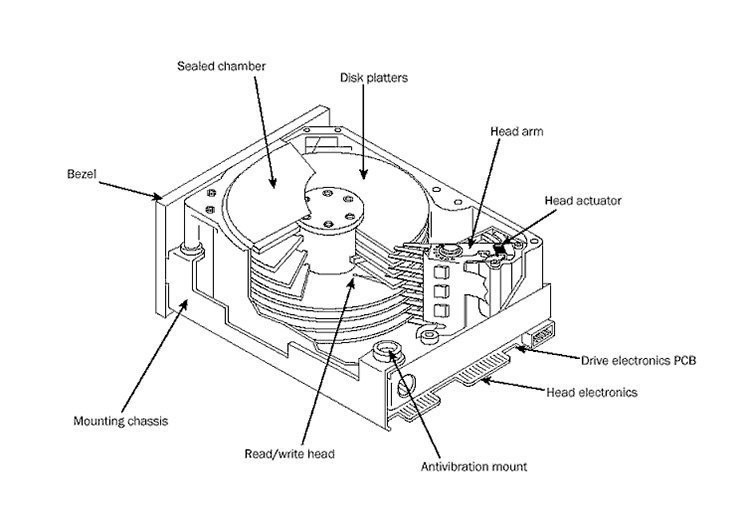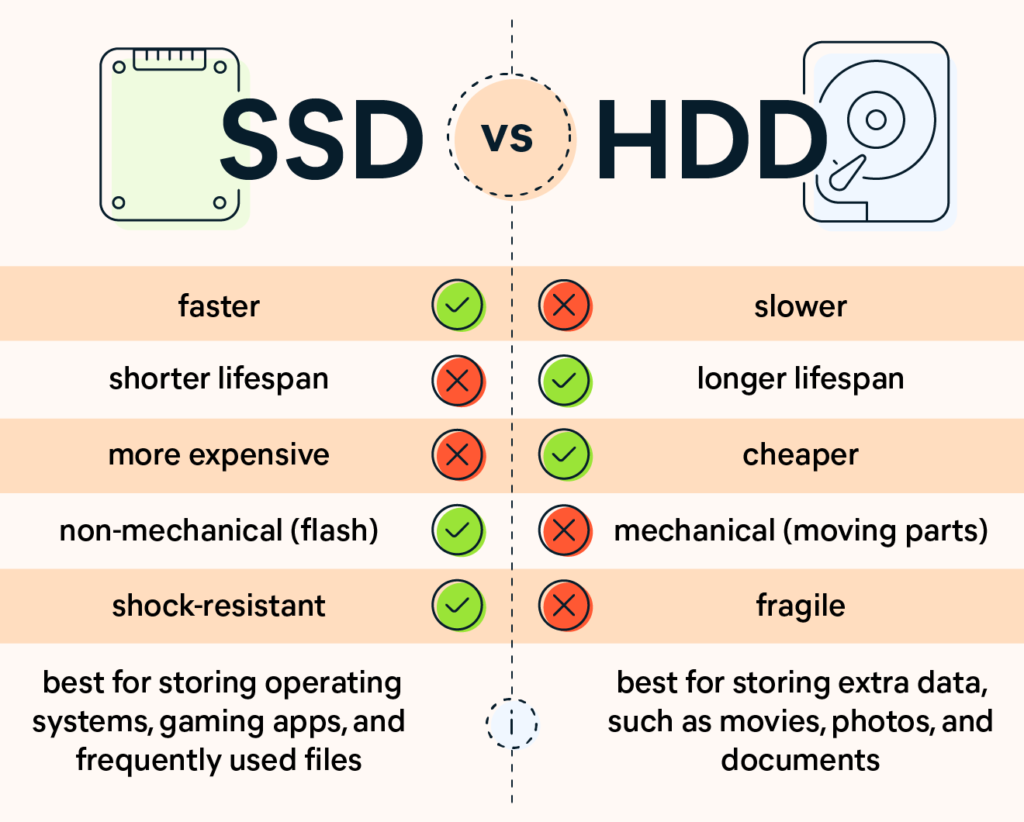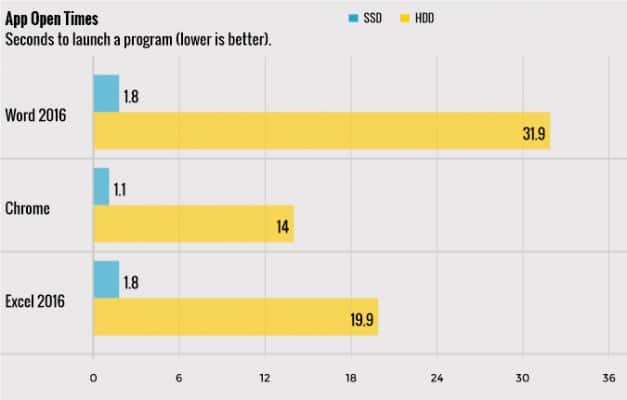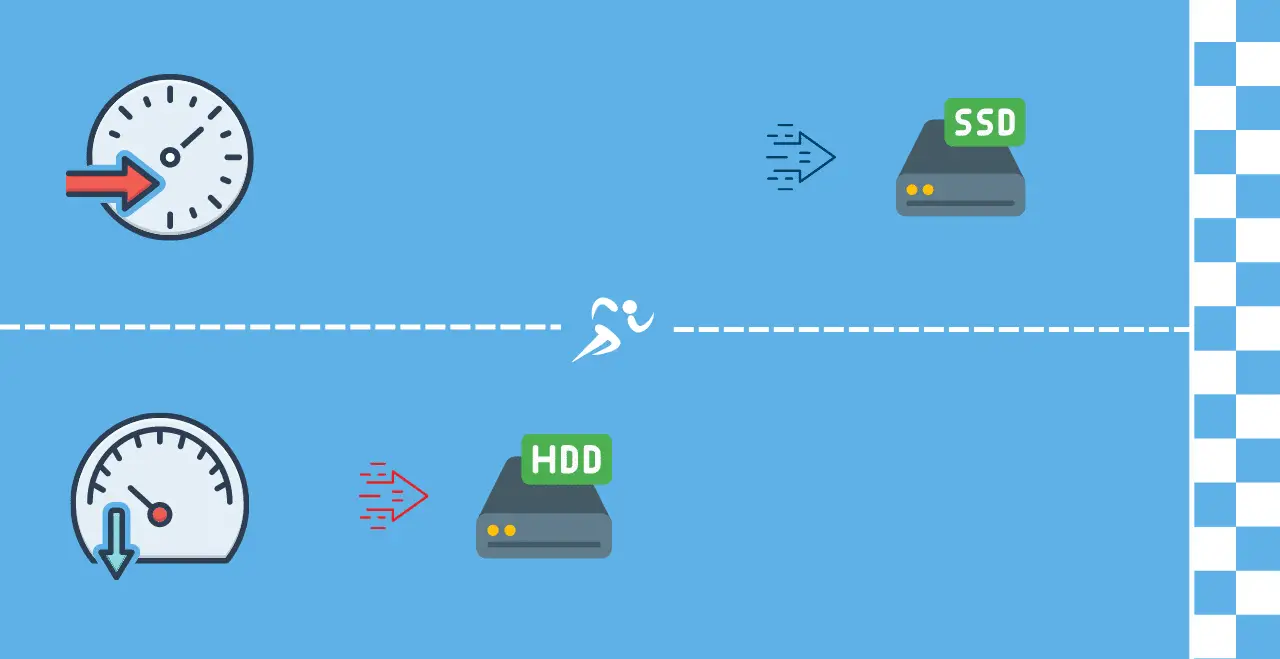If you’re considering upgrading your computer’s hard drive, it may be time to consider an SSD. These newer data storage devices use no moving parts, making them a more appealing choice for gaming and booting up the system. Energy-conscious individuals will also want to opt for SSDs because they consume less power than traditional hard drives. Whether for performance or power efficiency, an SSD will provide you with superior performance and less power consumption.
When it comes to price, capacity, and lifespan, a hard disk drive is a winner. If speed, ruggedness, form factor, noise, fragmentation, and durability are more important, an SSD may be the better choice. However, if these criteria were not so important, the hard drive would be the clear winner. SSDs are expensive and will not be a good option for budget buyers or those who don’t plan to use their computers for years.
What is HDD?

A Hard disk drive(HDD) stores data in the form of a stack of parallel platters that rotate at a constant speed. As the disk rotates, a head is used to read the data from the outer edge of the disk. Because the outer edges of the disk are generally less densely populated with data than the center, the same amount of data can be read from any position on the disk. These differences make hard disks much faster and more reliable than other types of storage.
A hard disk has a capacity of varying amounts, depending on the amount of data that is being stored. This storage device stores data for a long time, but the size can be quite large. Pre-installed operating systems and drivers use up space on the hard drive before any data is stored by the user. However, this free space can be used to store personal information. Though hard drives have been largely replaced by cloud storage, they still offer some incredible properties.
Why do computers need hard disks?
Hard drives are required for the installation of operating systems, applications, and extra storage devices, as well as for document storage. Without technologies such as hard disc drives (HDDs) that preserve data after they are powered off, computer users would be unable to save programs or save files, or documents on their machines. This is why every computer needs at least one storage device to retain data indefinitely.
Hard disk drive storage capacity
The following are some of the most frequently used storage disc capacities:
1. 16 GB, 32 GB, and 64 GB capacities. This is one of the lowest ranges for hard disc drive storage space and is often found in older, smaller devices.
2. 120 GB and 256 GB capacities. This range is commonly regarded as the starting point for hard disc drive (HDD) devices such as laptops or PCs.
3. 500 GB, 1 TB, and 2 TB are available. Typically, 500 GB or more of HDD storage is considered adequate for the average user. With this much capacity, users can most likely save all their music, images, movies, and other things. Individuals who play a lot of space-hogging games should find 1 TB to 2 TB of HDD space sufficient.
4. Greater than 2 TB. Anything greater than 2 TB of hard drive capacity is recommended for customers who work with high-resolution files, who need to store or house a big quantity of data, or who wish to use the space for backup and redundancy.
At the moment, the largest hard disc drive available is 20 TB. An HDD, on the other hand, has less space than claimed, as the operating system, file system architecture, and other data redundancy methods consume some of that space.
What are external HDDs?
The majority of hard disc drives are found inside in computers and operate in the manner described above. Individuals, on the other hand, can purchase external hard drives. External hard drives can be used to supplement the storage capacity of a computer or as a portable backup device. External drives connect to a computer or device using USB 2.0, USB-C, or external SATA ports (eSATA). Additionally, external hard drives may have slower data transmission speeds than internal hard drives.
Apart from the ability to enhance the storage capacity of a device, the primary advantage of an external hard drive is its portability. Users may save data from various devices and carry it around with them physically.
What is SSD?

If you’re wondering, “What is SSD?” read on. This low-latency flash memory is faster than the traditional hard disk drive (HDD), and it’s also less noisy than HDDs. SSDs may be different from HDDs, but their fundamental differences are the same. A solid-state drive has one or more NAND chips, and it manages the data between them. The first SSDs to be introduced were Sandforce, and while they have been prone to performance issues, today, these are generally considered to have good performance.
Solid-state drive (SSD)
The SSD is the future of computing. With no moving parts, it is faster and can save data up to ten times faster. Its average copy speed is 500 MB/s, compared to up to 150 MB/s for HDDs. An SSD’s high speed will deliver faster boot times and data transfer. SSDs also consume less energy than HDDs, and they’re more energy efficient. But what’s the best way to choose an SSD?
The first mass-marketed SSDs were Samsung’s 32-GB flash drives with a PATA interface. A year later, OCZ Technology introduced a 1 TB flash-based SSD, and Intel’s SDD DC S3700 drive came on the market. And in 2012, reliable enterprise-grade flash drives were finally available, including Intel’s SDD DC S3700. The next generation of SSDs was not as expensive and is starting to rival HDDs in price and performance.
Low-latency flash memory
Using 3D NAND technology to build Low-latency flash memory is the way to go, but Western Digital did not reveal the specifics of the product. But they do intend to close the gap between DRAM and 3D NAND. That’s good news for Flash memory users. While it doesn’t have the same levels of performance as DRAM, it’s much more reliable and has a longer lifespan.
Western Digital is currently developing a type of low-latency flash memory called LLF. This memory will be faster than ordinary 3D NAND but slower than DRAM, which can be more expensive. The technology is similar to what Toshiba has developed for its new NAND QLC memory technology, which can increase storage density beyond that of TLC. In addition, Toshiba has begun planning for future generations of BiCS flash memory. The low-latency flash memory is an excellent option for notebooks and other devices that require higher storage density than standard 3D NAND.
Faster than traditional hard disk drive
When it comes to performance, SSDs are undoubtedly a big plus. This is because they are able to perform smaller read/write operations at faster speeds, which makes them feel more responsive than traditional hard disk drives. Most tasks on a computer require the operating system to access small groups of data. HDDs typically access small groups of data at speeds ranging from 0.1 to 1.7 MB/s, while SSDs can offer speeds of 50 to 250 MB/s for 4K read/write operations. Even before SSDs became popular, they were already significantly faster than their HDD counterparts.
The difference in speed is largely due to the way in which they store data. SSDs store data in blocks of digital data, and HDDs rely on spinning platters to access data. While SSDs are faster, the HDD is cheaper per megabyte. However, desktop computers often have an HDD as secondary storage. If you’re not ready to part with your primary drive, you can choose an SSD if you’re on a tight budget.
Less noisy than HDD
One reason that SSDs are less noisy than HDDs is their low power consumption. Even the quietest hard drive makes noise when operating. As hard drives contain moving parts, the higher the power consumption, the louder they get. An SSD uses much less power than a standard hard drive, and this can greatly increase battery life. HDDs can be quite noisy, and they’re also prone to corruption. Backup your data regularly to avoid any unnecessary problems.
HDDs produce noise due to their spinning disks and their mechanical arms. These arms move in a circular motion and a reading/writing head is required to wait for the platter to rotate to write data to it. SSDs, on the other hand, don’t have moving parts. They are also less susceptible to crashes. Because they don’t have moving parts, SSDs are less noisy than HDDs.
Cost
Compared to conventional hard drives, SSDs are not particularly expensive, if you compare different capacity points. That said, the prices are not uniform across verticals, and it is important to know the costs of each type to make an informed decision. Here is a breakdown of the costs for SSDs in different verticals. The table below details the costs of common SSD capacities, and also provides a comparison of the cost of NAND and other components used in SSD production.
In Q1 2022, SSD prices will dip, recouping some of their higher initial prices through energy efficiency. On the other hand, SSDs will need to be replaced more often than HDDs, especially if they’re used in high-frequency writing workloads. So if you’re looking for a discount on SSDs, don’t wait. Now’s the time to buy! You can buy high-end enterprise-class SSDs for just a few hundred dollars.
Disadvantages
One of the main drawbacks of SSDs is that they have a limited number of write/delete cycles, which means they can lose their performance faster than HDDs. Even though they last longer than HDDs, they are not as efficient for heavy data usage. One of the ways to overcome this is to buy a higher-end SSD, but this is expensive and not practical for the average user.
As an SSD has no moving parts, it can withstand shocks better than an HDD. As a result, it is less susceptible to wear and tear. Compared to an HDD, it is also more resistant to temperature changes. However, these benefits aren’t enough to compensate for its disadvantages. There are a few other drawbacks to SSD. Here are the main ones. SSDs are generally silent, but their high-end counterparts can produce noise.
SSD vs HDD: What’s the difference?
The primary distinction between a solid state drive (SSD) and a conventional hard disc drive (HDD) is in the manner in which data is stored and retrieved. A hard disc drive (HDD) is a type of conventional storage device that accesses data using mechanical spinning platters and a moving read/write head. SSDs are newer, quicker devices that store data on memory chips that are instantaneously accessible.

Why are SSDs useful for laptops?
SSDs enable your laptop to boot faster, transmit data more quickly, and operate at a greater bandwidth. Due to SSDs’ faster speeds, it is possible to execute applications like an operating system that access vast volumes of data at the ultra-speeds required in today’s commercial environment.
Laptop Mag upgraded a Dell Inspiron 15 5000 with a Core i5 processor and 8 GB of RAM from a 5,400 rpm hard drive to a 250GB SSD, and the time it took to load Word 2016 dropped from 31.9 seconds to 1.8 seconds. Loading the Chrome browser went from 14 seconds to 1.1 seconds and Excel went from 19.9 seconds to 1.8 seconds.

Speed: HDD vs SSD
The difference in speed between an SSD and a HDD is most noticeable when copying and transferring large files. HDDs can copy data at a rate of 30 to 150 megabytes per second (MB/s), whereas typical SSDs can copy at a rate of 500 MB/s. Recent NVME SSDs can achieve speeds of up to 3,000 to 3,500 MB/s.
A 20 GB movie can be copied in less than ten seconds with an SSD, but it would take at least two minutes using a hard disc. Upgrade your Mac to an SSD or install an SSD on your PC for a noticeable performance gain.

Lifespan: HDD vs SSD
With normal use, solid state drives typically survive around 10 years, a lifespan comparable to that of a traditional hard disc drive. This was not always the case, as the cells in a solid state drive are only capable of being written to and read from once. In comparison, HDDs have a potentially limitless read/write capacity, providing the internal mechanisms remain functional.
SSD life expectancy has increased to its current level due to new technology like as wear-leveling. While SSD memory is still limited by a finite number of operations per second, the devices have advanced to the point where the entire computer will need to be replaced long before the capacity limit is reached. Additionally, because SSDs lack moving components, you won’t have to worry about mechanical issues.
Indeed, SSDs are currently replaced 25% less frequently than HDDs, implying that the longevity of your laptop continues to increase in comparison to what you’re used to (as long as you keep your drivers updated, and perform other necessary maintenance, of course). That is a really compelling case to upgrade to an SSD.
Storage Capacity: HDD vs SSD
If you’re concerned about the amount of data that each sort of drive can hold, have no fear. There are no distinctions in terms of storage capacity. HDDs and SSDs are available in a range of capacities, from 128 GB to 20 TB or more. However, bigger SSDs remain more expensive – we’ll explore pricing in further detail in the following section.
Price: HDD vs SSD
The price of SSDs has decreased in recent years, but still, they are more expensive per gigabyte than HDDs. This is not going to change very soon. The cost of raw materials and the complexity of the device’s fabrication make SSDs more expensive for the producer.
There is no limit to the amount of data that can be stored on a hard disc drive because it is made up of a single piece of metal. Because the transistors are getting progressively smaller, it’s very remarkable that SSDs only cost twice as much per gigabyte as HDDs.
Another reason for the high price of SSDs is the fact that many people do not use them. There’s no rush for producers to have supplies ready or lower their prices when demand is low.
Keep in mind that low-cost SSDs are frequently constructed with poor materials. Avoid purchasing an SSD from an unknown or unreliable manufacturer to avoid receiving a poor SSD.
Reliability: HDD vs SSD
Are SSD drives more durable than HDDs? Actually, SSD technology is now just as good as your old hard drive. We don’t store a lot of data in the form of music or movies on our drives anymore because of live streaming and cloud storage facilities. This is a good thing for SSDs because they can handle a lot of data at the same time.
People buy SSDs because they can handle daily tasks much faster, which require a lot of reading and writing. In other words, reliability is the most important thing about an SSD.
It has been a long time since SSDs have come a long way. TRIM and wear-leveling are two new optimization techniques that put performance first and keep the individual storage cells from getting worn out, so they can last a long time. The only thing you’ll notice when you switch from an HDD to an SSD is how much faster your computer will be.
So, which one should you get?
Can you tell me whether an SSD or a hard drive is better for me? That is all up to your preference.
Does your work frequently include dealing with huge files? SSDs are especially beneficial to the following individuals:
- Producers and editors of video and other media
- Videographers
- Photographers
- Users of Photoshop and other related applications
The extra price of SSDs may not be worth the improved performance for some users.







